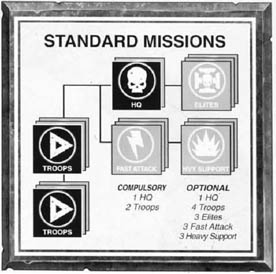|
A game of Warhammer 40,000 can use as many models as you can collect. The army lists included in the Warhammer 40,000 Codex books specify the precise characteristics and abilities of each troop type, detail how many you can use and provide a points value for each. The better a combatant is, the more points it will cost. Normally a soldier will have a basic cost, which is then increased if you upgrade his equipment or abilities. The most popular approach to playing a game of Warhammer 40,000 involves both you and your opponent selecting forces to a previously agreed points limit. A limit of 1,500 points per side produces a well-balanced game that can be concluded in a couple of hours. As you build up your armies and enter the ranks of the veteran gamer, you will no doubt crave opportunities to get your entire figure collection onto the battlefield and play with bigger points values. Don't be in a mad rush to play huge points limit games - it is far better to start small and gain familiarity with the rules rather than trying to master everything at once. You will inevitably make mistakes in your first few games, so it is better to play a number of small, quick games to learn the ropes before moving up to a full-size game. As detailed in each army Codex, all the forces you can use are categorised broadly by type. These types are: HQ, Elite, Troops, Fast Attack and Heavy Support, and these categories tell you something about the role the troops in question play in the army. HQ: A Headquarters unit might be a single heroic commander or powerful monster, possibly accompanied by personal guards or with a transport vehicle. These units are amongst the most powerful in the game, as leaders will generally have access to more special equipment than everyone else. They are not invincible but can provide a powerful spearhead for an attacking army, and a strong core for a defensive one. Every army will contain at least one Headquarters unit to command it. ELITES: An Elite unit will normally be a powerful but rare option. Elite choices are often the best soldiers an army has to offer, but there are never enough of them. In some cases they will be specialists, while at other times they will be more experienced versions of the regular rank and file soldiers. TROOPS: Troops represent the most commonly available soldiers in an army. This does not mean they are poor fighters though; the category includes such troops as Space Marines and Eldar Dire Avengers, both formidable adversaries. These are the warriors that make up the bulk of an army and, as such, every army will have at least two such units. FAST ATTACK: Fast Attack units are generally (surprise, surprise!) faster than their comrades and are expected to fight in a more dashing and decisive way. Often they will be responsible for reconnaissance and scouting, while at other times they will be specialist assault troops relying on speed to strike at the heart of the enemy. HEAVY SUPPORT: Heavy Support units are literally the big guns of the army. In this section you will find the heaviest items of equipment and the most powerful creatures. However, these units are also often the most expensive in points, so an over-reliance on them could see you being heavily outnumbered. FORCE ORGANISATION CHARTThe minimum and maximum numbers ot each of these types of unit are detailed on a Force Organisation chart. One box on the chart allows you to make one selection from that part of your army list. Dark boxes are compulsory selections. As you can see from the Force Organisation chart opposite, which is used for all Standard Missions, you will always have to take at least one Headquarters selection and two Troops selections. These compulsory choices ensure that whatever else you select, your force will have a core within it that is representative of that army. This is rarely a disadvantage and many players often use the maximum number of Troops selections. Sometimes a single choice on the Force Organisation chart will allow you to select more than one unit. This will always be explained in the appropriate Codex so be sure to read it carefully.
As your collection of miniatures grows, the urge to use them all at once will become hard to resist. Above a total 2.500 points, the Force Organisation chart deliberately becomes a real limiting factor. The chart allows you to build the minimum sized force that can reasonably be expected to complete a mission. On a larger scale, an army will consist of many such detachments, each performing separate missions. If you want to play an especially large game then, as well as agreeing a points limit, you should also agree a maximum number of detachments. Each detachment will be a separate army, using its own Force Organisation chart. |
||
